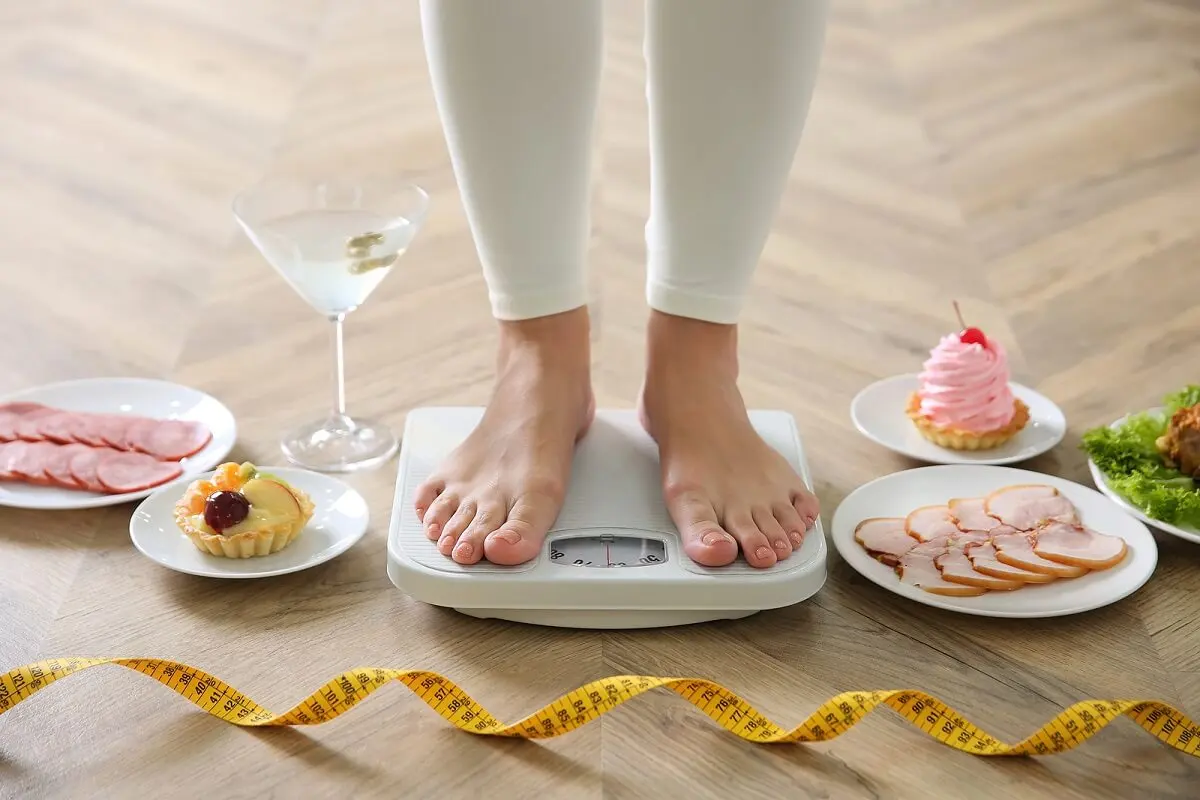Disordered Eating and Eating Disorders: What's the Difference?


Written and verified by the nutritionist Maria Patricia Pinero Corredor
Eating behavior is multi-dimensional and has many possible causes. The socio-cultural factor has become a double-edged sword, as it has often focused on the “beauty myth.” By promoting a healthy lifestyle, certain body standards are enforced in society. Thus, many people’s behaviors are altered, and disordered eating or eating disorders can occur.
But what is this?
Actually, they’re two different concepts. The obsession and demands to lead a fit lifestyle, comply with the fashionable diet trends, and count calories – among other clichés – can put a person at risk for mental, emotional, and physical health problems. Thus, it’s possible to move from an eating problem to a pathological one.
Disordered eating is not an eating disorder. However, it’s not normal behavior and carries risks. Here, we’ll show you how to recognize the warning signs of disordered eating and give you some tips on how to deal with it.
The characteristics of disordered eating
According to the Center for Young Women’s Health, the term “disordered eating” is used descriptively. It’s not used to diagnose an eating disorder. However, a person’s behaviors and patterns may put them at risk of developing a disordered eating disorder.
Disordered eating is when meals are eaten for reasons other than hunger and nutrition. In fact, a review gives some examples, such as the following situations:
- Bored or stress eating
- Skipping meals
- Emotional eating
- Skipping major food groups
- Eating the same thing every day
The same review explains that there’s a fine line between disordered eating and an eating disorder. Obsessive behavior about quantities and types of food may lead to binge eating disorder. Also, it can also happen when the person becomes extreme and restrictive with dieting, which can lead to anorexia nervosa.
In other words, disordered eating groups together unhealthy eating and body behaviors to lose weight or promote health. When this situation is maintained over time, the person is at risk of suffering diseases and self-esteem problems.

We think you might like reading: How Many Calories Do We Need? Should We Count Them?
Common symptoms of disordered eating
Disordered eating can cause serious damage to health. Because of this, the magazine Psychology and Health explains that you need to be aware of warning signs that allow you to recognize them. This includes the following:
- Constant weight fluctuations
- Long-term yo-yo dieting
- Extremely rigid diets and exercises
- Obsessing over the body, exercise, and food
- Anguish over your self-image
- Compulsive or emotional behavior
- Feelings of guilt or shame when unable to stick to a diet or exercise plan
- Using compensatory measures, such as food restriction, extreme exercise, fasting, and even laxatives
- Skipping meals
- Acquiring digestive problems
- Binge eating
- Counting calories
- Problems with low self-esteem
- Avoiding social engagements that include food
How to differentiate disordered eating from eating disorders
Phillipa Hay and Jane Morris, in their chapter on eating disorders, stress that the most important difference between disordered eating and eating disorders is whether the person’s symptoms and experiences meet the diagnostic criteria for an eating disorder.
When someone says, “I have problems with eating,” they’re describing their behavior with food, but without a definite diagnosis. However, if they meet certain criteria, it could be classified as an eating disorder not otherwise specified. However, it’s also possible that the symptoms may not be extreme enough to be diagnosed as an eating disorder.
An article shared in Eating, and Weight Disorders states that an individual with disordered eating has similar behaviors to those with eating disorders. However, the symptoms are less frequent and less severe.
Meanwhile, through The American Journal of Clinical Nutrition, a group of specialists determined that if disordered eating is not addressed and treated in time, it can become anorexia nervosa, a binge eating disorder, or bulimia. These diseases can present themselves differently in each patient and have lifelong consequences.
Possible health effects
Although at first it may go unnoticed, disordered eating has negative consequences on both your physical and mental health. Many of them are even life-long consequences. Let’s take a look at the main effects.
Common eating disorders
Eating disorders cause obsessive thoughts about food seven days a week, 24 hours a day. The person thinks only about calories, exercising, meal planning, or engaging in binge eating or purging. Consequently, there’s an increased risk of the following serious eating disorders:
- Anorexia nervosa: A Cambridge University review describes this term as an eating disorder classified by the detrimental alteration in body image and shape. There are several types. Restrictive anorexia is when food is restricted to lose weight or prevent weight gain. Other types include binge eating and purging through laxatives, diuretics, induced vomiting, or extreme exercise.
- Bulimia nervosa: Another literature review describes bulimia as a severe eating disorder that is characterized by eating excessive amounts of food in a short time, i.e., binge eating. This is followed by guilt and shame, often resulting in self-induced vomiting, laxative abuse, and extreme exercise.
You might find this article interesting: The Best Tips to Combat Food Cravings
Other types of eating disorders related to bulimia and anorexia
Choate and Gintner state that anorexia and bulimia have much in common, as both disorders involve binge eating and purging. These authors have chosen to consider binge eating and purging as a subtype of eating disorders.
Binge eating disorder
This subtype of disorder is the most common, as it’s present in both anorexia and bulimia.
A recent article explains that binge eating and purging are characterized by episodes of heavy eating, followed by self-induced vomiting, abuse of diuretics, laxatives, or excessive exercise. In binge eating, control is lost while eating.
Self-induced vomiting
This type of vomiting is a type of purging behavior.
It also includes excessive exercise and abuse of laxatives and diuretics. It’s often followed by episodes of “out-of-control” binge eating. In addition, people who self-induce vomiting will often eat a lot and quickly regardless of whether they’re full.

Other health problems
A group of doctors found that other consequences of disordered eating include increased risk for obesity, bone loss, gastrointestinal disorders, low heart rate, low blood pressure, water and electrolyte imbalance, depression, social isolation, and increased anxiety.
How to Correct Eating Disorders
Fortunately, there are tools that can help control disordered eating before an eating disorder occurs. The journal Pharmacology & therapeutics explains how to prevent and correct these disorders. Here are some recommendations.
Accept your body as it is
Don’t criticize yourself when you look in the mirror and think of your body as a vehicle that allows you to move through your day. Replace negative internal dialogue with positive statements. Acknowledge all the amazing things your body can do.
Avoid fad diets
It’s recommended to adopt a healthy way of eating in moderation. This will prevent feelings of deprivation.
Put away the scale
Using a scale can be obsessive and lead to extreme weight loss patterns. Replace the scale and experience how you feel about your body and how your clothes fit. Remember: be kind to yourself and don’t compare yourself to others.
Schedule a healthy exercise plan
You should consider how often you exercise and set a goal. Rather than see it as a sacrifice to lose weight, you should enjoy it.
Get professional help
If your eating behaviors are severe, seek professional help. A dietitian experienced in eating disorder counseling or a psychotherapist can help you practice healthier eating, as well as help you to face what may have led you to this unhealthy behavior, to begin with.
Ideally, a multidisciplinary treatment team should be there to help you address all triggers. This team should work closely together to help you achieve health goals. There’s a good chance of overcoming disordered eating with timely and appropriate intervention.
All cited sources were thoroughly reviewed by our team to ensure their quality, reliability, currency, and validity. The bibliography of this article was considered reliable and of academic or scientific accuracy.
- Toledo-Morales, P. & Sánchez-García, J.M. (2006). Trastornos de la conducta alimentaria en el contexto escolar. En M.J. Gómez & P. Toledo-Morales (Coord.), Educación para la salud: la promoción de estilos de vida saludables en la escuela, (pp. 80-100). Sevilla: @prende-iea. ISBN: 978-84-690-1076-1.
- Center for Young Women´s Health.Trastornos Alimenticios: Información General. Disponible en: https://youngwomenshealth.org/2001/06/29/desordenes-de-la-alimentacion/#:~:text=Alimentaci%C3%B3n%20desordenada%20es%20un%20t%C3%A9rmino,de%20desarrollar%20un%20trastorno%20alimenticio.
- Reyna María Cruz Bojórquez, María Luisa Ávila Escalante, María de la Cruz Cortés Sobrino Rosalía Vázquez Arévalo, Juan Manuel Mancilla Díaz. Restricción alimentaria y conductas de riesgo de trastornos alimentarios en estudiantes de Nutrición. Psicología y Salud. 2008, 18, 2, pp. 189-198.
- Marie Galmiche, Pierre Déchelotte, Grégory Lambert, Marie Pierre Tavolacci, Prevalence of eating disorders over the 2000–2018 period: a systematic literature review, The American Journal of Clinical Nutrition, Volume 109, Issue 5, May 2019, Pages 1402–1413, https://doi.org/10.1093/ajcn/nqy342
- M Yannakoulia , A L Matalas, N Yiannakouris, C Papoutsakis, M Passos, D Klimis-Zacas. Disordered eating attitudes: an emerging health problem among Mediterranean adolescents. Eat Weight Disord, 2004 Jun;9(2):126-33. doi: 10.1007/BF03325056.
- Jamie-Lee Pennesi, Tracey D. Wade, A systematic review of the existing models of disordered eating: Do they inform the development of effective interventions?, Clinical Psychology Review, 2016, Volume 43, Pages 175-192, https://doi.org/10.1016/j.cpr.2015.12.004.
- Brockmeyer, T., Friederich, H., & Schmidt, U. (2018). Advances in the treatment of anorexia nervosa: A review of established and emerging interventions. Psychological Medicine, 48(8), 1228-1256. doi:10.1017/S0033291717002604
- Savani Bartholdy , Peter Musiat, Iain C Campbell, Ulrike Schmidt. The potential of neurofeedback in the treatment of eating disorders: a review of the literature. Eur Eat Disord Rev, 2013 Nov;21(6):456-63.
- Choate, L. H., & Gintner, G. G. (2016). Feeding and eating disorders. In B. Flamez & C. J. Sheperis (Eds.), Diagnosing and treating children and adolescents: A guide for mental health professionals (pp. 315–339).
- Serra, R., Di Nicolantonio, C., Di Febo, R. et al. The transition from restrictive anorexia nervosa to binging and purging: a systematic review and meta-analysis. Eat Weight Disord (2021). https://doi.org/10.1007/s40519-021-01226-0
- Dooley-Hash S. (2021) Acute Care of Eating Disorders. In: Zun L.S., Nordstrom K., Wilson M.P. (eds) Behavioral Emergencies for Healthcare Providers. Springer, Cham. https://doi.org/10.1007/978-3-030-52520-0_19
- Himmerich H, Kan C, Au K, Treasure J. Pharmacological treatment of eating disorders, comorbid mental health problems, malnutrition and physical health consequences. Pharmacology & Therapeutics. Published online August 2020. doi:10.1016/j.pharmthera.2020.107667
- Hubertus Himmerich, Carol Kan, Katie Au, Janet Treasure, Pharmacological treatment of eating disorders, comorbid mental health problems, malnutrition and physical health consequences, Pharmacology & Therapeutics, Volume 217, 2021, 107667, ISSN 0163-7258, https://doi.org/10.1016/j.pharmthera.2020.107667. (https://www.sciencedirect.com/science/article/pii/S0163725820301972)
- Sergio Melotto, Clinical pharmacology of eating and not eating, Current Opinion in Pharmacology, Volume 14, 2014, Pages 1-5, ISSN 1471-4892, https://doi.org/10.1016/j.coph.2013.09.015. (https://www.sciencedirect.com/science/article/pii/S1471489213001884
This text is provided for informational purposes only and does not replace consultation with a professional. If in doubt, consult your specialist.








